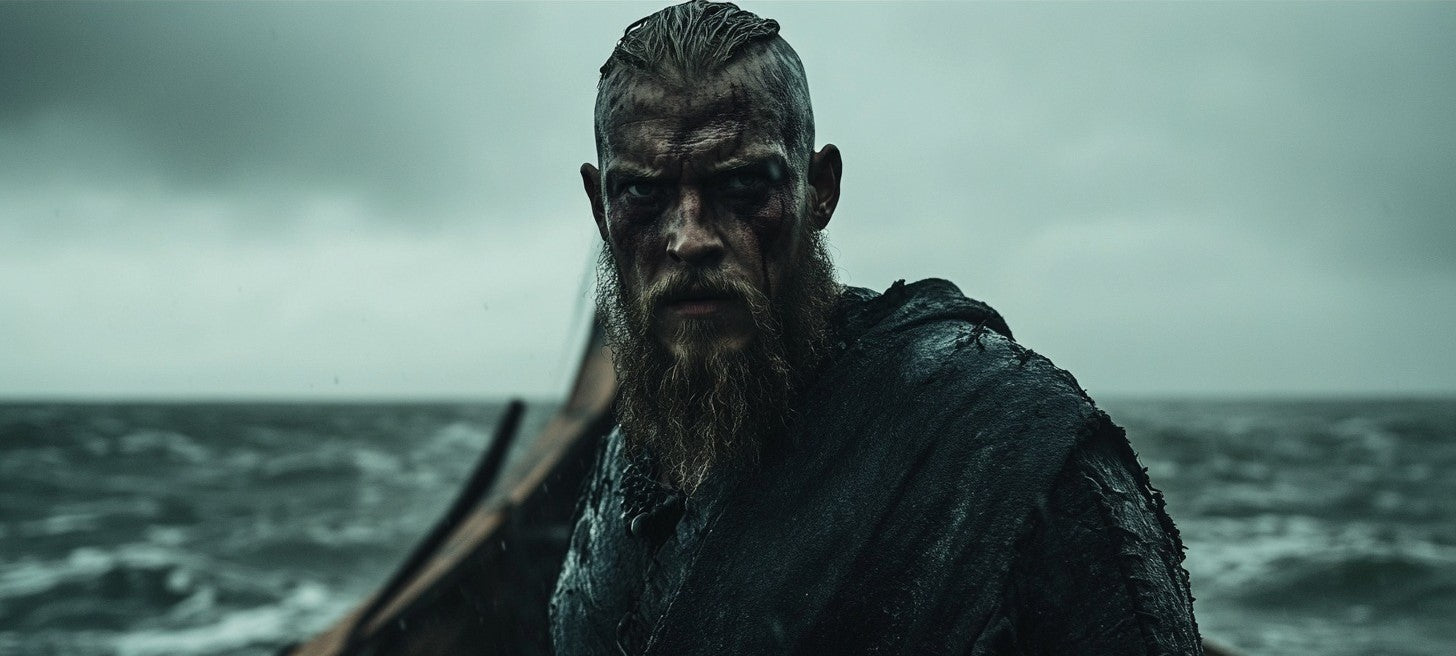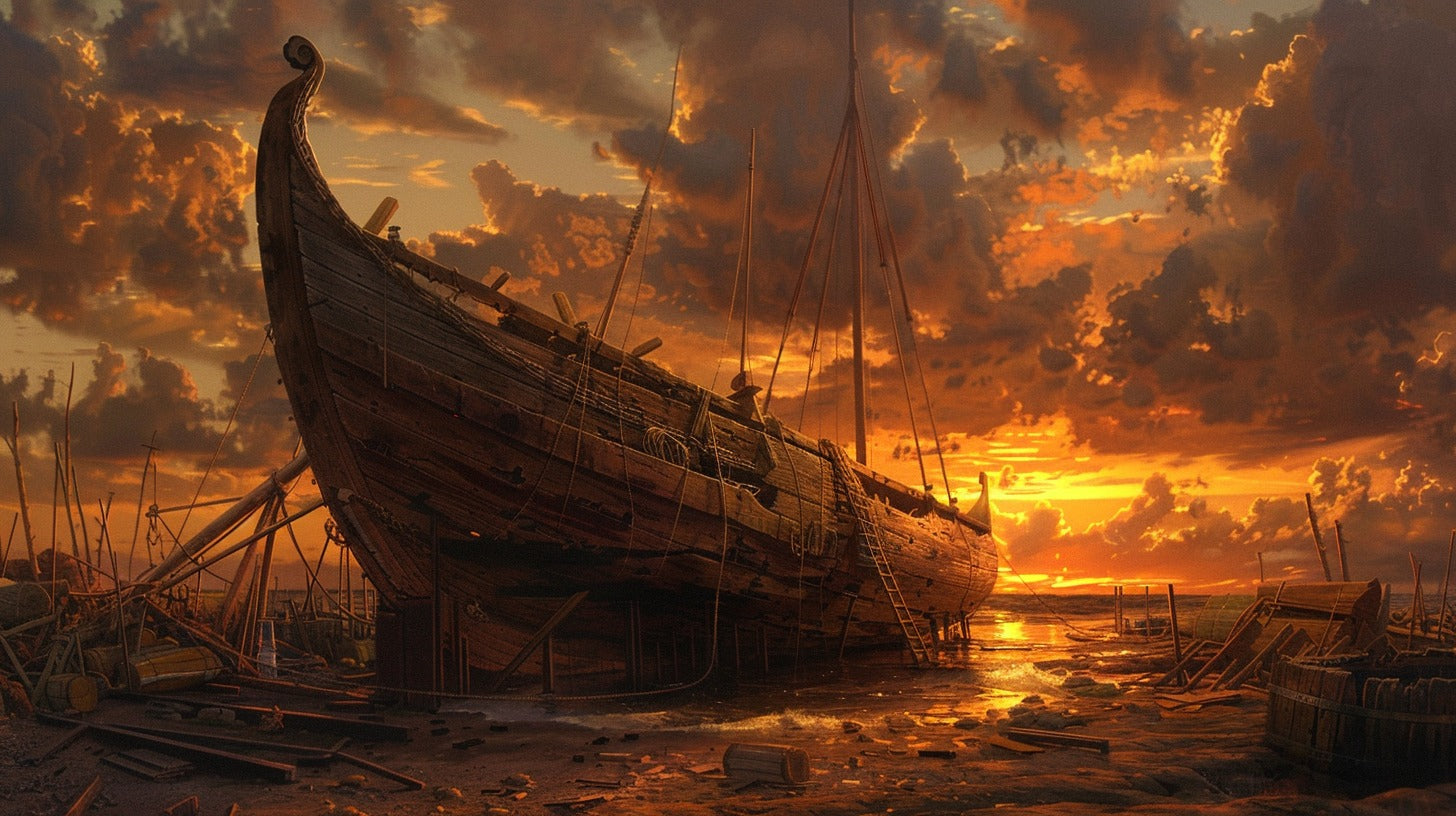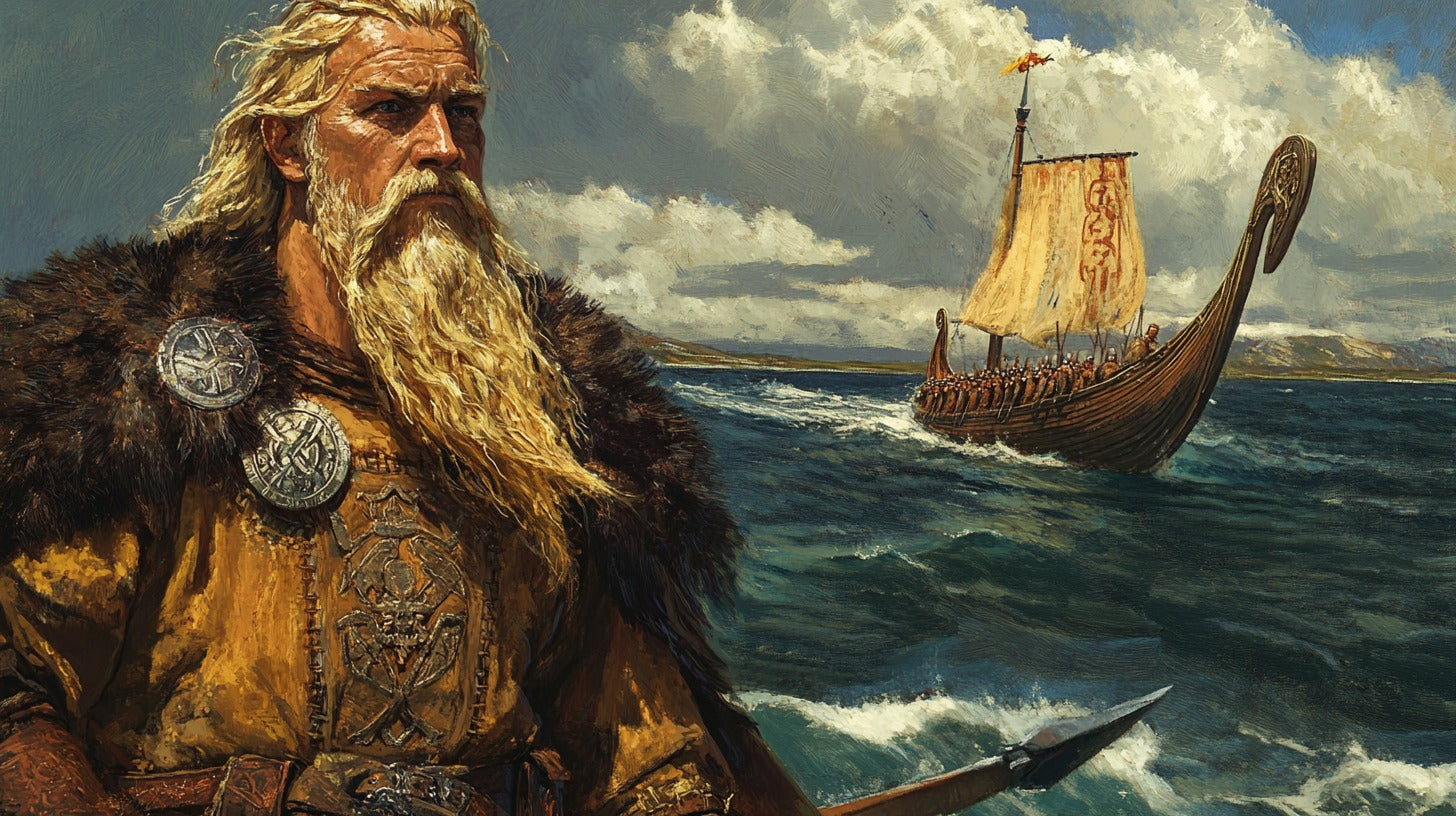
Ragnar Lothbrok: The Viking Hero Time Forgot (or Invented)
In the misty fjords of Scandinavian history, where fact and legend dance an intricate waltz, there looms a figure both revered and questioned: Ragnar Lothbrok. His name echoes through the ages, conjuring images of a fearsome warrior-king whose exploits have captivated imaginations for centuries. But as we peer through the veil of time, a pressing question emerges: was Ragnar Lothbrok a flesh-and-blood hero of the Viking Age, or is he merely a mythical construct, born from the sagas and songs of a bygone era?
The Saga of Ragnar Lothbrok

Origins of the Legend
The tale of Ragnar Lothbrok first unfurls in the pages of medieval Norse sagas, those grand narratives that blended history with myth, fact with fantasy. Chief among these is the "Tale of Ragnar's Sons," a 13th-century saga that paints Ragnar as a legendary king and fearsome warrior. But like the sea mists that shroud the fjords, the true origins of Ragnar's story remain elusive.
Ragnar's Fabled Exploits
If the sagas are to be believed, Ragnar's life was a tapestry woven with threads of incredible adventure. They speak of a man who slew a monstrous snake to win the hand of his first wife, Thora. They tell of daring raids on England and France, of a cunning leader who outsmarted his foes as often as he outfought them. And perhaps most famously, they recount his legendary death in a pit of snakes, defiantly composing poetry as the vipers' venom coursed through his veins.
The Viking Age: Historical Context

Norse Expansion in the 9th Century
The era in which Ragnar supposedly lived was one of great upheaval and expansion for the Norse people. From the late 8th to the mid-11th centuries, Scandinavian raiders and traders left an indelible mark on European history. Their longships were both the terror and the marvel of the age, allowing them to strike with lightning speed and vanish like ghosts on the tide.
Political Landscape of Scandinavia
The political landscape of 9th-century Scandinavia was as complex and shifting as the Northern Lights. Petty kingdoms vied for power, alliances were forged and broken, and ambitious leaders sought to carve out empires. It's against this backdrop that we must consider the possibility of Ragnar's existence.
Searching for the Historical Ragnar

Contemporary Chronicles
When we turn to contemporary sources, the waters become even murkier. Frankish and Anglo-Saxon chronicles of the 9th century do mention Viking leaders who could potentially be identified with Ragnar. The Anglo-Saxon Chronicle speaks of a "Ragnall" who raided Paris in 845 AD. Frankish sources tell of a "Reginheri" who led a similar attack. Could these be our Ragnar?
Archaeological Evidence
Archaeology, that great revealer of hidden truths, offers tantalizing hints but no smoking gun. Excavations have uncovered evidence of extensive Viking activity in the areas where Ragnar supposedly roamed. Great halls, buried treasures, and the remains of longships all speak to the reality of Viking power. But nothing definitively points to Ragnar himself.
The Sons of Ragnar: Myth Meets History

Bjorn Ironside: Son of Ragnar or Unrelated Warrior?
Bjorn Ironside presents a particularly intriguing case. While traditionally viewed as one of Ragnar's most famous sons, recent scholarship has cast doubt on this connection. Some historians argue that Bjorn may have been a separate historical figure, unrelated to Ragnar, whose exploits were later woven into the Ragnar saga.
Bjorn appears in multiple historical sources as a Viking leader who raided in the Mediterranean. His exploits are recorded with a degree of detail that lends credence to his historical reality. However, the debate continues as to whether he was truly Ragnar's son or if this familial connection was a later literary invention.
Ivar the Boneless
Ivar the Boneless is mentioned in Irish annals and Anglo-Saxon chronicles. He's described as a fearsome warrior and cunning strategist who led the Great Heathen Army that invaded England in 865 AD and later moved on to Ireland. The level of detail in these accounts suggests a basis in historical fact, though his connection to Ragnar remains a subject of debate.
Ubba: The Often Overlooked Son
Ubba, sometimes spelled Hubba, is another figure associated with Ragnar's lineage, though he's often overshadowed by his more famous brothers. Historical sources mention Ubba as one of the leaders of the Great Heathen Army alongside Ivar. The Anglo-Saxon Chronicle records his death in Devon in 878 AD, suggesting he was a real historical figure. However, like his brothers, the direct connection to Ragnar remains uncertain.
Sigurd Snake-in-the-Eye
Sigurd Snake-in-the-Eye, while less prominent in historical sources, is mentioned in connection with Viking activities in Denmark and England. His name, like those of his brothers, appears too consistently across various sources to be easily dismissed as pure fiction, yet the historical evidence for his existence is less robust than for Ivar or Ubba.
Ragnar in Modern Culture

Pop Culture Representations
In recent years, Ragnar Lothbrok has experienced a resurgence in popular culture. TV series like "Vikings" have brought his legend to life for a new generation, blending historical elements with dramatic license. These portrayals, while entertaining, often blur the line between fact and fiction even further.
Impact on Viking Stereotypes
Ragnar's story has become so intertwined with our perception of Viking culture that it's hard to separate the man (if he existed) from the myth. He embodies many of the qualities we associate with Vikings: bravery, cunning, a thirst for adventure, and a complex relationship with fate and the gods.
The Interplay of Myth and History

Oral Traditions and Saga Writing
To understand the Ragnar conundrum, we must consider the nature of oral tradition in Norse culture. Stories were passed down through generations, growing and changing with each telling. Historical figures could become legendary heroes, their deeds exaggerated and supernatural elements added over time.
Political Motivations in Medieval Literature
We must also consider the political context in which the sagas were written. In the 13th century, when many of these tales were first committed to parchment, there was a vested interest in creating grand narratives of Norse heritage. Ragnar's story may have been embellished or even invented to serve political ends, providing a legendary ancestor for ruling dynasties.
Conclusion: The Lasting Impact of Ragnar's Legend

19th-century artist's impression of Ælla of Northumbria's execution of Ragnar Lodbrok by Hugo Hamilton
As we navigate the treacherous waters between myth and history, what can we conclude about Ragnar Lothbrok? The truth, like the man himself, remains elusive. Perhaps Ragnar was a real Viking leader whose exploits were magnified by time and telling. Or maybe he's a composite figure, an amalgamation of various historical Vikings woven into a single legendary tapestry.
What's undeniable is the power of Ragnar's legend. Whether he lived and breathed or exists only in the realm of myth, Ragnar Lothbrok embodies the spirit of the Viking Age. His story speaks to something primal in the human psyche – the desire for adventure, the struggle against fate, the quest for immortality through deeds and offspring.
In the end, perhaps the question of Ragnar's historical reality is less important than the impact of his legend. Like the great sagas themselves, Ragnar's tale continues to inspire, to provoke thought, and to connect us with a past that, while shrouded in mist, still holds profound relevance for our understanding of history, culture, and the human spirit.
FAQs
- Were any of Ragnar Lothbrok's supposed sons real historical figures?
There is stronger historical evidence for some of Ragnar's sons, particularly Ivar the Boneless and Ubba, who are mentioned in various contemporary chronicles. However, their direct connection to Ragnar remains debated.
- What is the meaning of 'Lothbrok' in Ragnar's name?
'Lothbrok' is often translated as 'shaggy breeches' or 'hairy breeches'. According to legend, Ragnar earned this nickname by wearing a special pair of pants to protect himself when fighting a poisonous serpent.
- Is there any archaeological evidence directly linked to Ragnar Lothbrok?
While there's abundant archaeological evidence of Viking activities from the period when Ragnar supposedly lived, no artifacts or sites have been definitively linked to Ragnar himself.
- How has modern popular culture influenced our perception of Ragnar Lothbrok?
TV shows like "Vikings" have dramatically increased public interest in Ragnar, but they've also further blurred the line between historical fact and dramatic fiction.
- If Ragnar Lothbrok didn't exist, why was his legend created?
Legends like Ragnar's often serve cultural and political purposes. His story may have been created or embellished to provide a grand ancestral figure for royal dynasties, to explain historical events, or simply as entertaining sagas that embodied Viking ideals. |
References
Winroth, A. (2014). The Age of the Vikings. Princeton University Press.
Haywood, J. (1995). The Penguin Historical Atlas of the Vikings. Penguin Books.
Ferguson, R. (2009). The Hammer and the Cross: A New History of the Vikings. Allen Lane.
McTurk, R. (1991). Studies in Ragnars saga loðbrókar and Its Major Scandinavian Analogues. Medium Aevum Monographs.
Sawyer, P. (2001). The Oxford Illustrated History of the Vikings. Oxford University Press.
"Vikings" by uphillblok is licensed under CC BY-SA 2.0.








